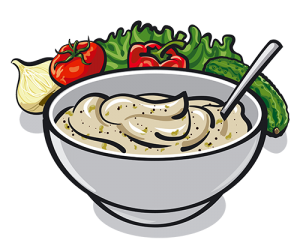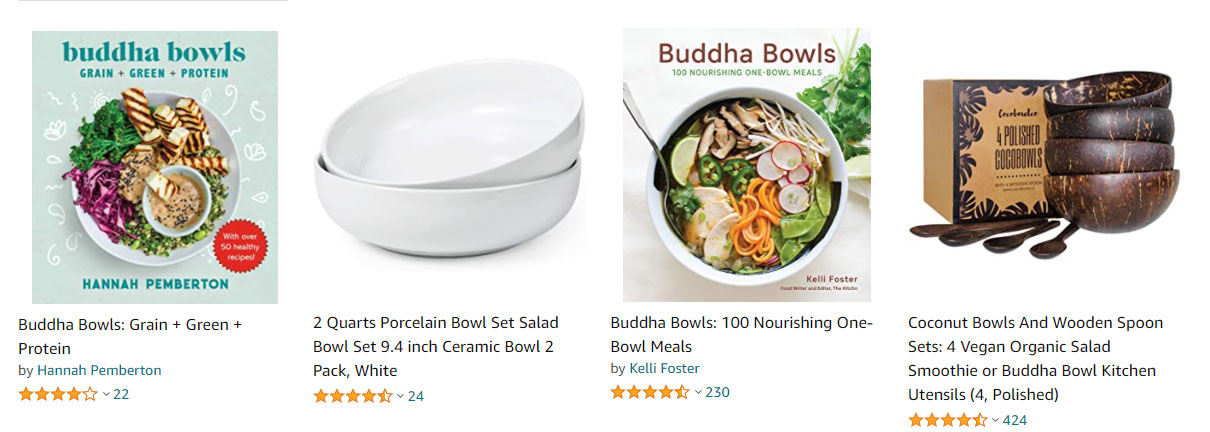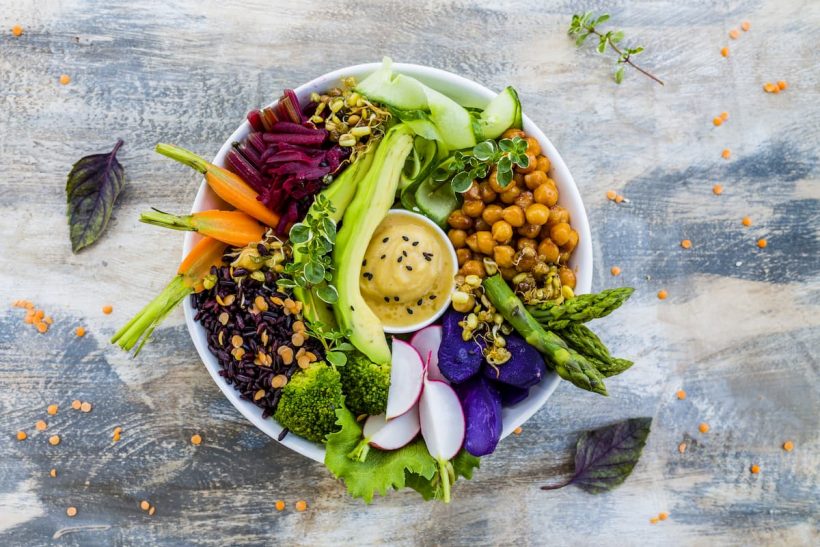Buddha bowl recipes
The Buddha bowl is one of the big healthy trends of the moment and when you think about it, it's quite funny that this dish is named after the one we commonly picture as a smiling man with a big belly (even if in reality, Siddârtha Gautama was far from being a potbelly).
The Buddha bowl, sometimes called "glory bowl" or "hippie bowl" is a hearty and nourishing dish made of raw or cooked vegetables, all kinds of beans and healthy cereals such as quinoa or brown rice.
There are also a variety of "toppings" that add texture and flavour to the dish, such as nuts, seeds or salad dressing.
There are literally an infinite number of possible combinations, and all you have to do is enter "Buddha Bowl Recipe" in Instagram/YouTube/Google/Pinterest to find out, and you'll see a rainbow of colors falling on your retinas!
But whatever the variation, the basic formula always remains the same, so as for the wok, I'm going to show you how to become the king/queen of the Buddha Bowl!
BUDDHA BOWL: WHAT IS IT REALLY?
The Buddha Bowl is a nourishing dish for the mind, the body and the eyes, it is a treat for all the senses and is directly on the list of my favorite meals to eat in full consciousness.
This is not a trendy Hippie Vegan delirium, it's a recipe that is :
• far from being bland and quick to prepare
• invites everyone's creativity (even if you don't know anything about cooking)
• is conducive to weight loss and a healthy diet
• completely vegetarian (and even vegan)
Yes, traditionally, the Buddha Bowl is always vegetarian (unlike the Nurrish Bowl and other Pokai), but no one will call the high authorities of gastronomy if you add meat or fish to it.
The food is usually cooked in small portions and separately from each other before being nicely arranged in a large bowl for a true taste masterpiece.
The concept is not new, it would have appeared in 2013 and become popular in early 2017.

As for the origin of its name, it could come from the presentation of a balanced meal (balance is a key Buddhist concept) or from the story that Buddha carried his bowl of food with him on the paths to fill it with local vegetarian villagers.
The Buddha Bowl is therefore a dish that reflects sharing and giving, so think about it when you invite your friends to dinner.
So much for the theory, now let's get down to practice with a little inspiration and an unmissable step-by-step recipe to make your own Buddha Bowl!
THE RECIPE FOR AN UNMISTAKABLE BUDDHA BOWL
1) Step One: Choose your cereal
You can opt for the classic white rice, or the healthiest wild rice or brown rice.
If you want to get off the beaten track, I invite you to consider quinoa, bulgur, polenta, farro, freekeh, kamut, millet, sorghum or amaranth.
The list is not exhaustive and you can choose to combine several of them, which is recommended when following a vegetarian diet (such as the combination of whole grain rice + quinoa).
Tip: to go faster, I advise you to invest in a pressure cooker to prepare large quantities of cereals that will be ready to use all week long.
2) Step Two: Opt for your favorite protein source
You can select any vegetarian (or non-vegetarian) protein source as :
• any type of bean (black, red, green, pinto, lima beans, mung beans, Paimpol coconut, etc.).
• all types of legumes (coral, green, black, chickpeas, split peas, lupin, edamame, etc.).
• hard-boiled eggs cut in half (if you are not vegan), marinated tofu, tempeh or seitan.
• vegetarian dumplings that you can make yourself, such as falafels for example.
3) Step 3: Add a touch of greenery
It is now time to choose the vegetables of your composition, they can be raw and/or cooked.
Raw vegetables are ideal to add a little texture and bring the freshness you want in summer, you can for example opt for :
• cucumbers (remember to seed them)
• tomatoes (from the garden if possible for an exquisite taste)
• sweet and crispy green onions (cebettes)
• finely sliced peppers
• grated cabbage, celery or carrots
• spinach shoots, arugula or any other salad
• thin slices of raw zucchinis
• strawberries, pomegranate or mango for absolute freshness
I advise you here to invest in a mandolin, the thinner your raw vegetables will be, the easier they will be to swallow and the more they will absorb the other flavors of your bowl. No one wants big chunks on their plate.
As far as cooked vegetables are concerned, I encourage you to select them according to the season, here are some choices that are full of taste:
• sautéed mushrooms with garlic
• baked beet and butternut cubes (try it's a delight)
• steamed cauliflower and broccoli florets
• baked cherry tomatoes with a drizzle of oil (seriously, try it!)
• sliced radishes, pan-fried in a frying pan
• golden plantain bananas with coconut oil
1 to 3 vegetables are enough, no need to overdo it, select a few raw vegetables and one or two cooked vegetables to obtain contrasting and colorful textures. Vary the combinations.
My best tip for people in a hurry is probably the following: invest in a steam cooking system for your vegetables, you will preserve all the nutrients and ensure that your choices are healthy. No need to spend a lot of money, the best steaming is also the dumbest, in a bamboo steaming basket.
Another very fast way to cook your vegetables is in the oven! Cut all your vegetables into cubes/rounds, then place them on baking paper on a baking tray, drizzle with olive oil and turn the oven at 180°. Turn your vegetables regularly during cooking. However, be aware of the different cooking times for different foods (for example, beets and carrots are cooked first, then cherry tomatoes and zucchinis 10 minutes later, etc.).
4) Season properly!
Usually, the Buddha Bowl is decorated with a good little dressing that is not too caloric so as not to make this healthy dish counterproductive! You can then choose a slightly creamy vinaigrette with tahini or a citrus-flavoured vinaigrette with lemon/lime juice.
Here are the 3 quick and healthy sauces that I personally like to make for myself to sublimate my "creations" (need to have a blender):

- mix together: 80g of cashew nuts (which you have soaked beforehand), 1 madjool date, 1c.c of paprika powder, 1c.c of onion powder and 1c.c of garlic powder, 1c.c of oregano, 1c.c of cumin, the juice of 1/2 lemon and 230ml of water,
- 2 cloves of garlic, 200g of cooked chickpeas, 2c.s of tahini, 1 madjool date, 1c.c of onion powder, the juice of 1/2 lemon, 200ml of water, salt to taste
- 1/2 avocado, the juice of 1 lime, 1 big handful of coriander, 1c.c of garlic powder, 1c.c of spiracha and 200ml of water
If the sauces are too compact, do not hesitate to add a little more water. Adapt the proportions according to the number of guests, those indicated above will give you large jars of sauce, which you can keep in the fridge.
If you have a little more time in front of you, you can prepare a small satay sauce that goes very well with this type of dish.
5) Train properly!
Once all the ingredients are ready, it's time for the big dressage! Arrange the different ingredients in your bowl side by side by playing on the colors. Be careful not to put in too big portions, by experience, I know that you can quickly build up a bowl that's too big!
Once all the elements are in place, you can place in the center either a small jar of sauce or a rose made with an avocado that will make its little effect (tuto here).
All that's left to do is to sprinkle your vinaigrette and add a few decorative elements such as :
• crumbled cheese like feta (or vegan cheese if you are vegan).
• peeled almonds, sunflower seeds, coconut flakes, hemp seeds for extra protein, roasted hazelnuts, cashew nuts, pistachios, pecans, sesame seeds, flax seeds, etc. (choose only one kind so as not to overload your preparation).
• finely sliced herbs (coriander, chives, parsley, basil, fresh mint, dill, chervil, etc.).
Makes your mouth water? Good, because there are an infinite number of recipes to try and I promise you that you can't get tired of the Buddha bowl.
Don't fall into the trap of eating more than you're hungry, we often tend to overeat, especially when we have a lot of different ingredients. Do you have leftovers? Perfect, store them in a glass jar in the fridge and you'll have your next day's meal.
This dish is truly conducive to experimentation, improvisation and personalization according to seasonal fruits and vegetables and what you have on hand.
Try as many combinations as possible and, as much as possible, integrate healthy, organic, local and seasonal foods.


